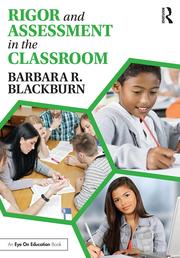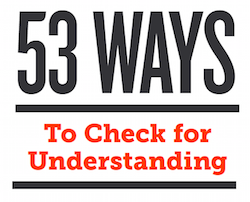Four Myths about Rigor in the Classroom
 By Barbara Blackburn
By Barbara Blackburn
When you hear the word rigor, what is your first response? Maybe it’s a negative one – rigor means hard, more homework, lots more failures in a classroom, high cut scores on standardized testing – or rigor is only for gifted or honors students.
A colleague of mine, James Beane, points out that if you look it up in the dictionary, rigor falls between rigamarole and rigor mortis. Isn’t that ironic?
True rigor is creating an environment in which each student is expected to learn at high levels, each student is supported so he or she can learn at high levels, and each student demonstrates learning at high levels. With the advent of the Common Core Standards, public school educators have become more focused on high expectations. I have something to say about that, but first let’s take a look at some common misconceptions about rigor.
Which of these myths, if any, do you believe?
Myth #1: Lots of Homework Is a Sign of Rigor
For many people this is the most prevalent indicator. Many teachers are proud of the amount of homework they expect of their students. It is often built on the idea that “more is better.”
Unfortunately the evidence is that “more” often means doing more low-level activities, often repetition of things done earlier. Because students learn differently, it is important to vary the instruction with the student and to use homework strategically, as an opportunity to deepen understanding of what has been learned.
Myth #2: Rigor Means Doing More
There is also a belief that students need to do more than they are currently doing. Tony Wagner of Harvard found that classrooms are often characterized by low-level, rote activity. A study by Howard Johnston and Ronald Williamson (my co-author on Rigorous Schools and Classrooms and Rigor in Your School) found that parents saw rigor as doing less but doing it more in-depth. That is often difficult for principals to reconcile when talking with teachers and other school personnel who may take a different view.
True rigor is expecting every student to learn and perform at high levels and requires that students delve deeply into their learning, engage in critical thinking and problem solving, and be curious and imaginative.
Myth #3: Rigor Is Not for Everyone
There is a belief that if everyone is engaging in rigorous activity, it somehow lowers standards and lessens the value. It shouldn’t. There is growing recognition that all students must be provided an opportunity for a rigorous educational experience that is more than just a set of courses. It is anchored in the belief that every student can be successful if given adequate time and sufficient support.
Myth #4: Providing Support Means Lessening Rigor
Rugged individualism characterizes the fourth myth. There are those who believe that if students are provided and accept support, it is a sign of weakness. We’ve found that providing support is an essential component of a rigorous school. Students are motivated to do well when they value what they are doing and when they believe they have a chance for success. When Howard and Ron talked with teachers and parents about their own positive rigorous experiences, they invariably shared the support that they were provided.
Rigor and the Common Core State Standards
Not long after the Common Core Standards were released, I spoke with an educator who told me, “This is the solution to increasing rigor in the classroom.” I wish rigor was that easy. The standards are a good beginning point, but only if we also pay attention to other aspects of rigor.
We cannot assume that simply adopting the standards provides a rigorous environment for students. Rigor is more than what you teach. It’s how you teach and how students show you they understand. The Common Core (and related state standards) provide an excellent foundation for increasing rigor in your classroom; however, there are other integral aspects of rigor to consider.
Let me repeat myself:
True rigor is creating an environment in which each student is expected to learn at high levels, each student is supported so he or she can learn at high levels, and each student demonstrates learning at high levels.”
Notice the key aspects of this definition:
First, you are creating an environment that is conducive to growth.

Next, focus on your high expectations.
The Common Core standards are reflective of higher expectations, but you have to reinforce that belief. How can we put high expectations into practice? By not allowing the word “can’t”, both from students and ourselves. By continually reminding students you know they can. You have to believe so your students over time will believe. A friend of mine says sometimes you have to believe for your students until they believe they can be successful.
The third aspect of rigor is supporting students so they can learn at higher levels.
This will require a focus on scaffolding within a lesson. Focusing on prior knowledge, modeling the thinking process behind learning strategies, and providing support for gaps that occur between their current knowledge and the standards are all critical. Some students will need extra help outside of class time, and that will require a schoolwide plan to provide those opportunities.
Finally, each student should demonstrate learning.
There are two aspects of this. First, provide a variety of ways students can demonstrate understanding. It’s fine to use questions that are similar to the final assessment, but also provide opportunities to play to students’ strengths. Allow them to show you they know through technology, drawings, projects, etc.
Then, as you use formative assessment to check for understanding, incorporate strategies for each student to participate. Using whole group instruction and asking one student to answer does not accomplish this goal. Use think-pair-shares, clickers, dry erase boards (or the whiteboard app for the iPad), or thumbs-up thumbs-down strategies so you can see if each student is understanding each part of the lesson.
This may sound daunting, but you are already demonstrating high expectations, providing support for students, and asking them to show you they understand. Building on these, you’ll create a climate that supports rigor.
Which of these aspects do you need to pay attention to today?
____________

Her latest books are 2017’s Rigor and Assessment in the Classroom and the 2nd edition of The Principalship from A to Z, written with Ron Williamson.

































I love this post. I have become grossed out by the word “rigor” because it has been used in destructive ways. Your article (and really all of your work) helps me see RIGOR as it should be. Your focus on GROWTH for each child is inspiring. Thanks for this post! I will share it far and wide.
Thank you, Rita! I love rigor, and I want everyone else to also. Be sure to visit my website–there are lots of free resources there. http://www.barbarablackburnonline.com